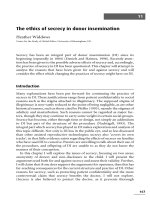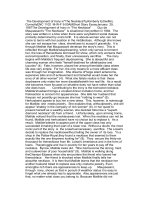The ethics of secrecy in donor insemination
Bạn đang xem bản rút gọn của tài liệu. Xem và tải ngay bản đầy đủ của tài liệu tại đây (152.71 KB, 16 trang )
11
The ethics of secrecy in donor insemination
Heather Widdows
Centre for the Study of Global Ethics, University of Birmingham, UK
Secrecy has been an integral part of donor insemination (DI) since its
beginning (reputedly in 1884) (Daniels and Haimes, 1998). Recently atten-
tion has been given to the possible adverse eVects of secrecy and, accordingly,
the practice of secrecy in DI has been questioned. This chapter will attempt to
analyse the reasons that have been given for and against secrecy and will
consider the eVect which changing the practices of secrecy might have on DI.
Introduction
Many explanations have been put forward for continuing the practice of
secrecy in DI. These justiWcations range from patient conWdentiality to social
reasons such as the stigma attached to illegitimacy. The supposed stigma of
illegitimacy is now vastly reduced to the point of being negligible, as are other
historical reasons, such as those cited by PfeVer (1993), namely the stigmas of
adultery and masturbation. Such reasons cannot be regarded as major fac-
tors, though they may continue to carry some weight in certain social groups.
Secrecy has become, either through time or design, not simply an addendum
to DI but part of the structure of the procedure (Nachtigall, 1993). The
integral part which secrecy has played in DI makes exploration and analysis of
this topic diYcult. Not only is DI less in the public eye, and so less discussed
than other assisted reproductive technologies; secrecy also ‘covers its own
tracks’, in that little evidence exists regarding the eVects of secrecy on families
who have used DI to conceive. Parents are unwilling to talk about their use of
the procedure, and oVspring of DI are unable to as they do not know the
manner of their conception.
In this chapter I will explore the issues of secrecy, focusing on two areas:
anonymity of donor; and non-disclosure to the child. I will present the
arguments used both for and against secrecy and assess their validity. Further,
I will claim that if one does support the arguments for openness, then this has
far-reaching consequences for the current structure and practice of DI. Other
reasons for secrecy, such as protecting patient conWdentiality and the more
controversial claim that secrecy beneWts the doctor, I will not explore.
(Secrecy is also believed to protect the doctor, as it prevents thorough
167
examination of the procedure – including doctors’ practices of making social
decisions about access and donors, which they are not qualiWed to make
(Haimes, 1993).) The rationale for such a selection is simply that I judge the
two selected areas to be the most important issues in the justiWcation, and
thus continuation, of the culture of secrecy in DI.
Donor anonymity
The ethics of donor anonymity in DI has become prominent over the last two
decades, and has been brought into relief by the removal of donor anonymity
in certain countries. Sweden was the Wrst country to introduce such a law, in
1985, followed by Austria, which introduced a similar law, in 1992. Such
identifying information is also available in New Zealand and Australia.
Changes to DI practice in these countries provide a context in which some of
the usual justiWcations for secrecy can be assessed. In addition, recent ad-
vances in genetics have strengthened claims that knowing one’s genetic
parentage is an important part of understanding one’s own identity (at least
medically). Moreover, such advances have also reduced the likelihood of
keeping non-genetic parentage secret. Taken together these factors have led
many to re-examine the traditional assumption that donor anonymity is the
‘self-evident principle of DI’ (Bateman Novaes, 1998: p. 119).
Two main reasons given for keeping the donor anonymous are: Wrst, a
practical reason, that anonymity is necessary to ensure that there are willing
donors; and second, that anonymity ensures that donors have the ‘correct
attitude’.
First, the supposition that if donor anonymity were removed, then donors
would no longer be willing to donate sperm can now be tested against the
evidence which is emerging in countries where anonymity has been removed.
The most detailed evidence comes from Sweden. The Swedish legislation
(Swedish Law of ArtiWcial Insemination, March 18, 1985, no. 1140/1984)
allows the DI ‘child’ access to identifying information about the donor when
she or he reaches maturity. Many predicted that outlawing anonymity and
making the donor identiWable would result in a dearth of donors and even the
end of DI; for example, two Swedish doctors wrote articles to this eVect
(Edvinsson et al., 1990, and Hagenfeldt, 1990, cited by Daniels and Lalos,
1995).
However, such predictions proved alarmist. After the introduction of the
law the number of donors did initially decrease, as did the number of DI
births, and simultaneously the number of couples travelling to other
European countries for DI increased (Daniels and Lalos, 1995). At Wrst sight
such evidence appears to suggest that both donors and potential parents were
uncomfortable with the removal of donor anonymity – donors were less
168 H. Widdows
willing to donate and parents were choosing to go to countries which
continued the practice of donor anonymity. However, this is not the only
explanation, and it is arguable that other factors were at work.
For example, Daniels and Lalos (1995) suggest that one alternative expla-
nation for the decline in donors derives from changes in legislation regarding
the screening of semen – namely, the compulsory testing of semen for HIV
before and after six months of cryopreservation. These changes resulted in
private clinics ceasing to oVer DI, which meant that donors were no longer
required, and that couples had no choice other than to seek treatment
elsewhere. A further possibility is that this increase in couples seeking treat-
ment outside Sweden is an indicator not of dissatisfaction among donors
with the removal of anonymity, but of the dissatisfaction of medical advisors,
who adopted the practice of ‘advising and referring couples to have treatment
outside Sweden’ (Daniels and Lalos, 1995: p. 1872). However, Daniels and
Lalos do note that their view is contested by Bygdeman (cited in Daniels and
Lalos, 1995), who argues that both the decline in donors and the trend for
couples to seek treatment abroad was a direct reaction to the fact that their
anonymity would no longer be protected.
To support the claim that donor anonymity does not stop donors from
donating, Daniels and Lalos surveyed the numbers of donors in the eight DI
programmes in Sweden between 1989 (the Wrst year that Wgures were re-
corded) and 1993. These Wgures show a steady increase in the number of
donors, and an overall increase of 65 per cent (Daniels and Lalos, 1995).
Unfortunately, there are no comprehensive Wgures from before the 1985
legislation. However, Daniels and Lalos conclude that ‘despite this limitation,
it is clear that the number of available donors is increasing’ (Daniels and
Lalos, 1995: p. 1873). To support this conclusion they cite statistics from the
University Hospital of Northern Sweden, which had collected donor Wgures
both before and after the introduction of the law. These Wgures show that the
number of donors pre- and post-legislation remained static, and later (co-
inciding with high-proWle recruitment campaigns) the number of donors
began steadily to increase, thus supporting their claim that despite the
removal of anonymity donor numbers are increasing.
From this evidence it can be concluded that removing donor anonymity
would not stop donors coming forward, but that it would cause changes to
the structure and current practice of DI. The two most notable changes in
Sweden were changes in public perceptions of DI, and more crucially to the
type of men coming forward to donate sperm. In order to encourage donors
to come forward, new strategies were needed and high-proWle recruitment
campaigns were introduced. These campaigns raised public awareness of DI
and thereby reduced the secrecy surrounding the procedure. The more
fundamental change was to the type of donors willing to donate. Before the
removal of anonymity, donors tended to be students who were motivated
169The ethics of secrecy in donor insemination
primarily by money, whereas donors recruited after the change in legislation
tended to be older, married men, who were motivated altruistically by a
desire to assist infertile couples (Daniels and Lalos, 1995). A similar change in
age, marital status and motivation of donors has been reXected in studies in
New Zealand and Australia (Daniels and Lalos, 1995: p. 1873). Thus, al-
though the predictions that removing anonymity would stop sperm donation
(and so DI) have proved false, notable changes have occurred. In one sense
the predictions were correct, in that the donors who donated before the
passing of the law (of those anonymous donors to whom the predictors had
access) did cease to donate once anonymity was removed. However, this
proved to be unimportant in terms of the overall number of donors, as other
donors were prepared to become non-anonymous donors.
In sum, then, the Wrst reason for continuing anonymity is unfounded –
donors will not cease to come forward. Hence only the second reason for
insisting on anonymity remains, namely, that anonymity ensures that donors
should have the ‘correct’ attitude to the procedure. Before the recent ques-
tioning of anonymity, the secrecy involved in the process of DI was taken for
granted and was unquestioningly assumed to beneWt all concerned (donor,
parents, child and doctor). In such a framework it was in the interest of all
parties to keep their involvement secret, and anonymity safeguarded secrecy
for both the donor and the parents. Accordingly, the correct attitude of the
donor was held to be detachment – the donor should not wish to know
anything about, or have any contact with, his potential progeny (Pennings,
1997). Anonymity guarantees that the donor provides his semen – the raw
material of DI – and that this is the end of his involvement; there is no hope of
any future knowledge of, or contact with, any oVspring resulting from his
donation. This attitude is further enforced by paying the donor’s ‘expenses’
(importantly, at least in the UK, expenses, not payment). Such reimburse-
ment provides some reciprocity which, at least symbolically, implies an end
to the encounter. In addition to providing a symbolic reciprocal act, the
money which changes hands does provide motivation for some donors.
Although the level of expenses is intended to be below the level of induce-
ment, for many young men (characteristically students) the expenses are
suYcient to function as inducement to donate (Daniels and Lalos, 1995; Lui
et al., 1995; Pennings, 1997). Indeed, it could be argued that this perception is
the one intended, as paying expenses encourages the sense of conducting a
transaction, which lowers any possibility of the donor feeling any entitlement
to future information or contact with any possible children. This is the
traditional model in which the donor simply provides ‘genetic material in
order to enable others to fulWl their wish to have a child. The donor is an
outsider who has no rights or responsibilities in the newly created family. The
procedure . . . completely severs the link between the donor and his genetic
material and thus, indirectly, isolates the donor from the recipients’ (Penn-
ings, 1997: p. 1842).
170 H. Widdows
Removing anonymity fundamentally alters the framework in which DI has
been practised and threatens the long-established culture of secrecy. Instead
of attracting donors who wish to have no contact with the oVspring their
sperm are used to create, donors are attracted who do not feel that anonymity
is important, and therefore are willing for their donor-oVspring to know who
they are, and perhaps even to be contacted by them.
The conclusion which must be drawn is that those who support the
continuing practice of donor anonymity do not fear that there would be no
men willing to donate, but rather that these donors would be the ‘wrong’ type
of donor. Changing the type of donor – from anonymous and Wnancially
motivated to identiWable and altruistically motivated – threatens the present
model of DI. No longer would a prime concern be to keep the procedure
secret and to keep the donor separate from the couple. While DI could still be
used to solve childlessness, the ethos of the procedure would be very diVerent.
In particular, instead of enforcing the pretence of a ‘normal’ family – by
which is meant the traditional (and many would argue outdated) model of
father and mother and genetically related children – the change makes
openness possible. Indeed, changing to identiWable donors implies disclosure
to the child. For while one can inform the child of his or her donor
conception, if donors are anonymous (the child would simply know she or he
was conceived through an anonymous donor) one cannot give the child
identifying information about the donor unless the child has Wrst been
informed of his or her status as a DI child. Thus, removing anonymity
challenges the culture of secrecy, in that while anonymity is in place parents
may feel that there is little point in revealing the fact of DI conception to the
child as no information about the genetic father is available. However, on the
removal of anonymity the reverse is the case – there is no point removing
anonymity unless parents tell their children. Hence, removing anonymity can
be seen as putting pressure on parents to reveal the mode of conception to
their children.
Secrecy, then, in the form of donor anonymity, does not protect donors as
a homogeneous class, but only a certain type of donor and thereby a certain
structure of DI. Removing anonymity aVects the culture of secrecy which has
been at the heart of DI, and implies huge changes in the way DI is regarded by
users and by society as a whole. Not only does removing anonymity put
pressure on parents, but it also presumes that society will accept DI as an
alternative means of family creation, in a similar manner to the way that
other assisted reproductive technologies and adoption have been accepted. It
could even be argued that removing anonymity introduces the presumption
that there should be a relationship between donor and donor oVspring,
something which is anathema to the traditional concept of DI.
171The ethics of secrecy in donor insemination
Secrecy and the family
The second key issue is secrecy in the family, more speciWcally the non-
disclosure by the parents to the child. (There are other elements regarding
secrecy and the family, such as between the ‘parents’, extended family and
wider friends and acquaintances, which could be addressed, however, there is
no room in this present chapter.) The practice of secrecy has been claimed to
protect the family – its individuals, their relationships with each other and
the family unit as a whole. An important reason which is given in defence of
secrecy in the family is that it protects the family from the stigma of male
infertility (Klock et al., 1994; Nachtigall et al., 1997; Lasker, 1998). Fear of
admitting male infertility is cited as a key reason for non-disclosure, and this
seems to be supported by the evidence, in that those who use DI to overcome
male infertility are less likely to disclose to the child. For example, couples
who use DI because of vasectomy, or to avoid passing on a genetic disorder,
are more likely to disclose than couples in which the man is infertile (Nach-
tigall et al., 1997; Lasker, 1998).
Crucially, when couples use DI, unlike all other assisted reproductive
technologies, there is no doubt that it is the man, and not the woman, who is
infertile. For example, even though IVF (in vitro fertilization) is often used
for men with low sperm counts (either naturally or after vasectomy), the
focus and presumption of infertility rests with the women (Spallone, 1989).
DI reveals male infertility, and so the ‘cultural assumption of infertility being
primarily a female problem is violated for these couples’ (Lasker, 1998: p. 14).
Male infertility does go some way to explain why couples do not disclose to
the child, and why there is less open acceptance of DI at a wider societal level.
This is linked to the wider topic of the importance of heredity and genetic
relatedness; however, due to the remit of this chapter, this issue will not be
discussed in detail, but should be noted as a signiWcant topic in the debate.
This chapter simply focuses upon whether secrecy is in the best interests of
the child, which is the primary argument in favour of non-disclosure.
Historically, the claim that secrecy is in the best interest of the child was a
strong argument in that secrecy protected the child from the stigma of
illegitimacy. Illegitimacy, however, is no longer a major concern, especially
when it is due to the use of assisted reproductive technologies. Thus, the
claim that secrecy is in the best interests of the child must be for other
reasons. The reasons that are given are: Wrst, that not knowing about the DI
conception guarantees the child stable and ‘normal’ family relationships, and
prevents any uncertainty about identity (which could result from knowing
about the DI conception); and second, that openness is damaging to the
child’s relationship with his or her parents, especially with his or her social
father (even to the point of rejection of the non-genetic father in extreme
cases). The opposing arguments for openness will in turn be presented.
172 H. Widdows









